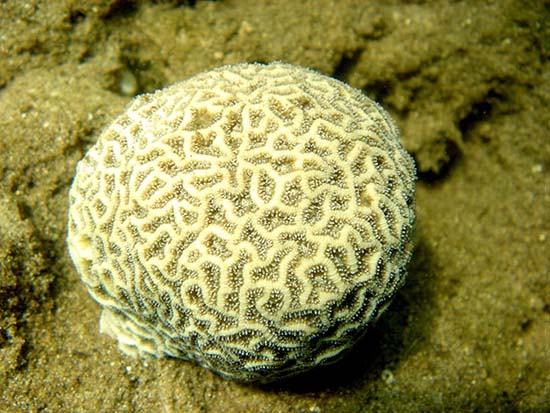The 10 most endangered corals
10 species of tropical coral have the most evolutionary and most endangered evolution (EDGE) globally, according to a new report by scientists from the London Zoology Association (ZSL) .
According to the Guardian (UK), coral reefs are the most diverse marine ecosystem in the world, considered the tropical rainforest of the ocean. Although they only account for about 0.2% of the ocean floor, they provide habitat for about one-third of marine species.

Anomastraea irregularis coral.
Scientists say that seawater temperature is increasing due to climate change causing coral bleaching phenomenon, and along with other causes such as excessive coral exploitation and ocean pollution killed Many coral reefs in the past decade. They predict that the ' worst ' case of coral reefs is that they can become extinct within the next 30-50 years .
According to scientists, up to 16% of the world's coral reefs were killed by coral bleaching in 1998; and 2010 is said to be one of the ' worst ' years of the epidemic, reports say, many coral reefs in Indonesian waters are 100% bleached.
In the face of this concern, the protection project prioritizes 10 tropical corals that are selected by EDGE from the world's famous coral reefs, from the largest Great Barrier coral reef in the world ( Australia) to coral reefs around the Chagos Islands (United Kingdom), from the ' coral triangle ' area surrounding Philippine waters to coral reefs in the western Atlantic Ocean around the Mozambique Canal and coral reefs in the Caribbean Sea.
Catherine Head - coordinator of the EDGE project - said that, as expected, the EDGE project will be implemented over a 2-year period. This project will provide intensive knowledge of corals as well as support the necessary funding for scientists to carry out research and protection of corals in the above coral areas.
Dr. Heather Koldewey, director of the international marine and freshwater conservation program at ZSL, said: ' Coral is one of the most threatened animal groups on the planet. The EDGE project contributes to improving resilience and ensuring future coral reefs thrive . '
Among 10 coral species belonging to EDGE project, there are some quite strange species such as pearl foam coral Physogyra lichtensteini, this is the source of food for the tortoise species Eretmochelys imbricata; and the species Heliofungia actiniformis, which is considered ' home ' for at least 15 species of shrimp.
Below is a close-up of tropical corals belonging to the EDGE project:

Brain coral Catenella chagius, endemic to the Chagos Islands.

Catalaphyllia jardinei coral.

Acropora palmata coral.

Dendrogyra cylindrus coral.

Dichocoenia stokesii coral in the Caribbean.

Horastrea indica coral.

Helio fungia actiniform coral.

Parasimplastrea sheppard coral.

Coral Physogyra lichtensteini.
- See Earth's 'prophetic' animals endangered
- Many plants and animals are in danger of extinction
- Acidification seriously threatens the marine environment
- Coral is the longest living animal on Earth
- What will happen if the entire coral reef on this Earth disappears?
- New hope for corals to die from global warming
- Vietnamese marine corals are severely destroyed
- Discovering corals in depths 'never thought of'
- The strange coral lives in the cave
- Artificial corals can clean seawater in China
- Is coral a plant or animal?
- Vietnamese corals are comparable to world corals
 Why do potatoes have eyes?
Why do potatoes have eyes? 'Tragedy' the world's largest carnivorous life: Death becomes ... public toilet
'Tragedy' the world's largest carnivorous life: Death becomes ... public toilet Tomatoes were once considered 'poisonous' for 200 years
Tomatoes were once considered 'poisonous' for 200 years Detecting microscopic parasites on human face
Detecting microscopic parasites on human face